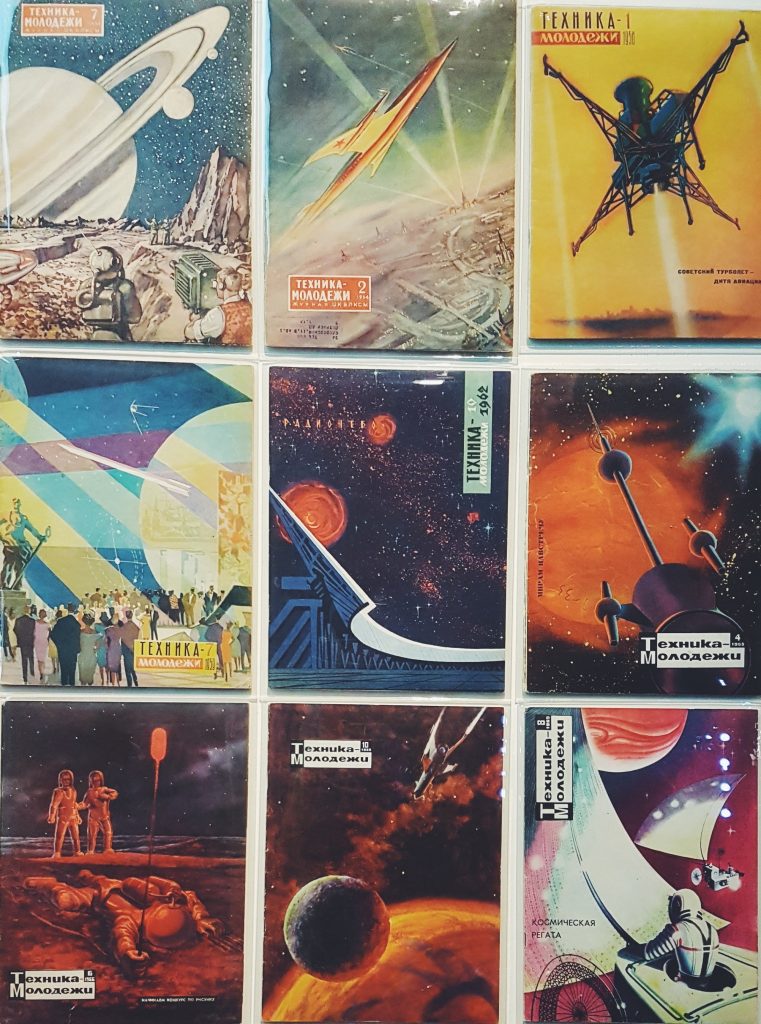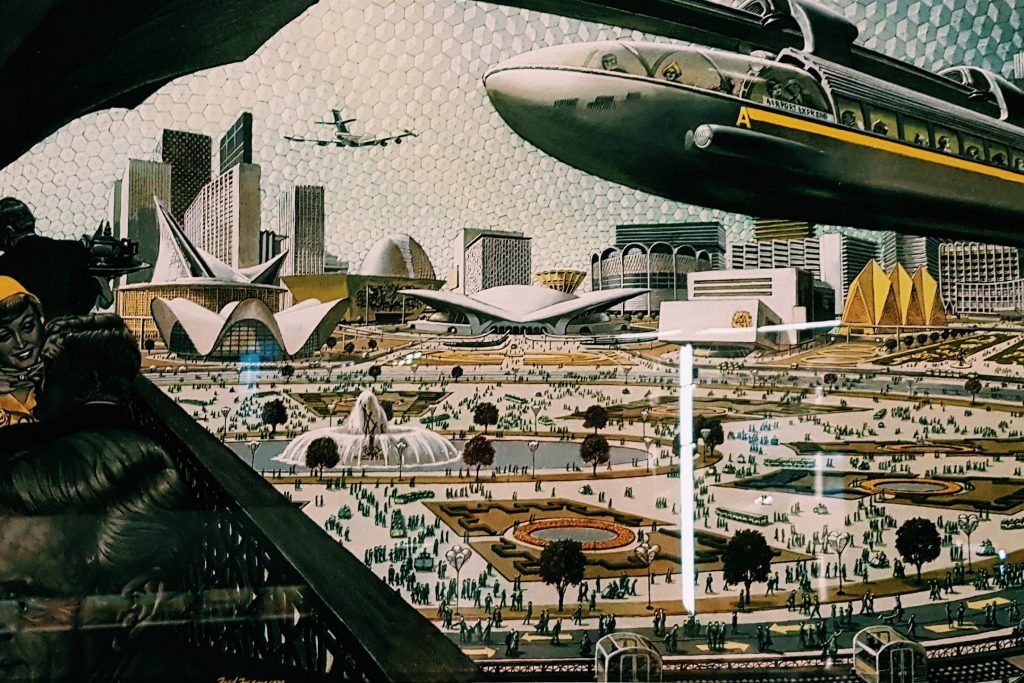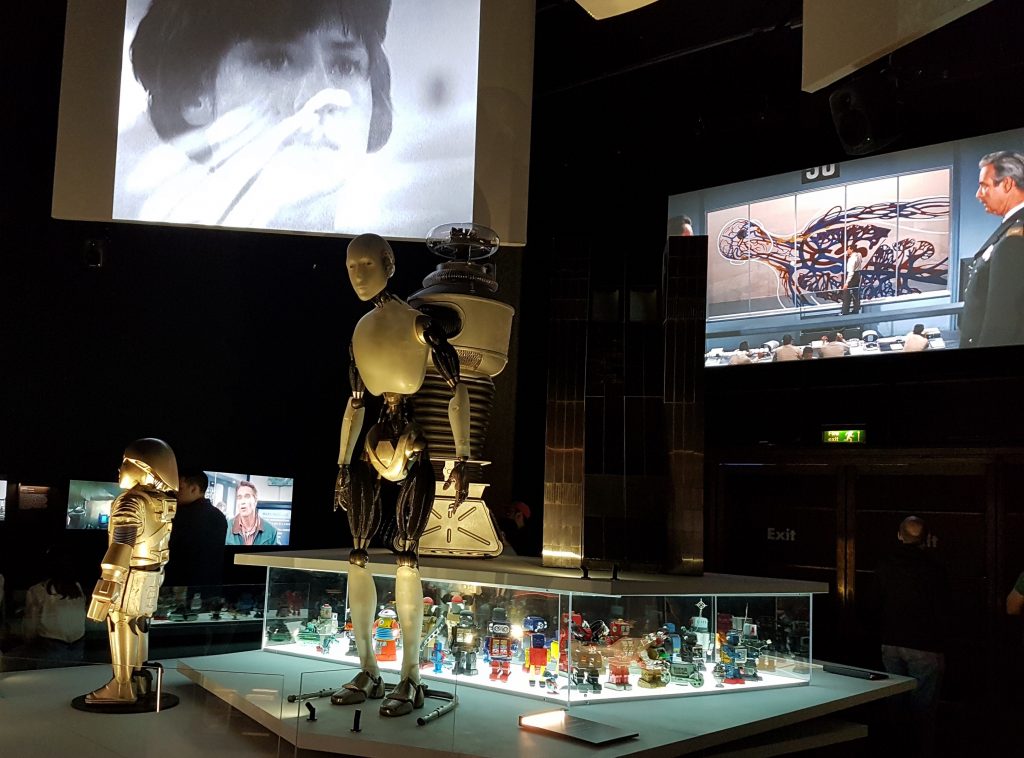
Modernist Sci-Fi aesthetics: Technology for Youth magazines, Russia, 1962-9 (photo taken at Into the Unknown exhibition)
I’ve always been fascinated by Science Fiction, and in this article I discuss discovering an organic architectural movement, reimagining alternative black futures through art, and a screenplay written by an AI, all inspired by exploring the histories of this genre.
I’ve previously written about the inspirational power of Sci-Fi in this post on Nerd Nite talks on the psychology of Dr Who, nanotechnology, and the economics of Star Trek, so it will come as no surprise that I was super excited about the Into the Unknown exhibition at the Barbican! This exhibition detailed the histories of Sci-Fi and its reciprocal relationship with society through artefacts from literature, film, games, art, comic books, and architecture.

Special effects head from the film, Aliens (1986) (photo taken at Into the Unknown exhibition)
The experience was geek-tastic for me (they even had an original skull from Aliens on display!), and really emphasised how Sci-Fi differs from “Futurology” which is non-fictional, “Fantasy” which is non-rational, and general “Fiction” which is largely non-speculative about possible futures. Conversely, Sci-Fi can be charactarised as creating a sense of wonder, but within a vision that is still credible as it often draws from real-world scientific and technological developments.
The exhibition highlighted the didactic elements of the genre and its power of holding up a sometimes uncomfortable mirror to society. It demonstrated how it has been used to expose inequalities, explore anxieties around technology and the future, and reflect the human fascination with exploring new territories- from undiscovered places on Earth, outer space, alien worlds, cities of the future, and even the body.
There was a huge range of awesome artefacts on display, but I’ll discuss three specific video installation exhibits that surprised and particularly inspired me to learn more about Metabolism, Afrofuturism, and the creative potential of AI.
Cities of the future: Japanese Metabolism

A mid-Century view of cities of the future: Fred Freedman, “Clean Air Park”, c.1959 (photo taken at Into the Unknown exhibition)
Throughout much of Science Fiction, the vast city or megalopolis is portrayed as the epitome of dwelling in the future. The enduring images of flying cars and megastructures seen in films such as Blade Runner (1982) were introduced as early as the 1939 World’s Fair in New York themed on “the world of tomorrow”. Artist, Pierre-Jean Giloux’s video Invisible Cities # Part 1 # Metabolism (2015 video 11m 4s), explores these cities of tomorrow, and is inspired by the Japanese Metabolism architectural movement of the 1960s.

Nakagin Capsule Tower (Image from Chris 73 / Wikimedia Commons)
The Metabolism (Shinchintaisha) movement was a school of thought in which cities are no longer considered static and permanent, but moving, organic, and ever changing to the adapting needs of contemporary life. This philosophy can be seen to reflect the post-war Japanese context where many cities had to be rebuilt. Equally, this renewal was expected and frequent due to recurring natural disasters, and buildings were often constructed from wood rather than the permanence of concrete and brick structures of the West. Drawing from the biological meaning of “metabolism”, cities and architectures were revinvisioned in a state of constant destruction and renewal to meet changing needs. This fluid attitude to architecture can be epitomised by the Nakagin Capsule Tower Building (1972) in Tokyo by Kisho Kurokawa (1934-2007), a founder of the Metabolism movement, where apartments are efficient, individual pods designed to be added and removed.
Giloux’s video installation draws on two unrealised and innovative architectural plans for buildings from the Helix City (1961) project by Kurokawa, and Arata Isozaki’s Cities in the Air (1962). These designs were inspired by helix structures of DNA, and the concept of a building as a tree: with the “trunk” as the permanent structural elements in the centre, and housing units as movable “leaves”. The video takes the viewer on a journey across the skyline of Tokyo, augmented with such fantasy buildings. The theme of continual change and impermanence is further enhanced with cherry blossom falling in the foreground.
The installation was captivating and presented a hopeful utopian vision of a future city comprised of light and spacious megastructures, something more along the lines of a positive Star Trek future, as opposed to Philip K. Dick’s dark and chaotic vision portrayed in Blade Runner (1982), or the crime ridden tower blocks of Mega-City One in Judge Dredd. While few of these architectural projects were actualised in full, the desire of the Metabolists to create better cities modeled on organic processes is a fascinating point in the history of architecture.
Seeing Differently: Afrofuturism
the goal is to…rethink what the future might look like through a black cultural lens…
Astro Black (2007-11 digital video 25m 45s) by Australian duo, Soda_Jerk, is a four part Afrofuturist video installation. It is comprised of a collage of images and sampling of speeches and music, which creates a piece inspired by science fiction, political history, and African American music culture. Juxtaposing images, music, and speech together, it creates new associations and meaning for black identity, beyond dominant (white) historical narratives.
Soda_Jerk’s signature collage of clips, from the lunar landings, political speeches, hip-hop music, and Sci-Fi films…
Creative machines: an AI screenplay

Exhibit on robots, cyborgs, and AI (photo taken at Into the Unknown exhibition)
Some of my favourite Sci-Fi explores the limits of the human and divides between mankind and machines. Influenced by radical politics of 1970s, Cyberpunk authors such as Philip K Dick, Octavia E. Butler, and Pat Cardigan for example, have broken down binary distinctions between male and female, human and machine. The human body has been portrayed as a “final frontier” within much Sci-Fi, and many works challenge Cartesian divides: the body can be joined with technology and “jacked in” to cyberspace in Neuromancer (Gibson 1984), enhanced with cyborg additions as portrayed in I, Robot (2004), and machines themselves have the potential to be “more human than human” in Blade Runner (1982).
A piece that goes even further to disrupt these divides is Sunspring (2016 video, 9m), a screenplay written entirely by an LSTM (long short-term memory) recurrent neural network AI bot. Conceived by BAFTA nominated director, Oscar Sharp and creative technologist, Ross Godwin, the AI system (named Benjamin) was “trained” on scripts from Alien (1979), Tron (1982), Moon (2009), and Star Trek (the original series) episodes, and a prompt was fed in to create a story- the winner of a competition at the Sci-Fi London film festival. The resultant screenplay was performed by three actors over two days, with intense and surreal results.
it raises the question of what is it to be human, when an AI system can replicate the creative process…
Overall, I would describe the play as “generated” rather than “crafted”, as the narrative doesn’t make sense (at least to my puny human brain!), and I doubt screenplay writers will be out of a job anytime soon. It was an interesting experiment though, and it raises the question of what is it to be human when an AI system can replicate the creative process, something usually considered to be the realm of the human mind.
The exhibition was extremely thought provoking, and I’m excited to dig deeper into these three themes, particularly Afrofuturism and its potential for alternative visions of an imagined future.
Thanks for reading! Hit Follow to receive brief notes letting you know that I’ve posted a new article, and in the meantime, check out the Instagram and YouTube channels for more (Un)Popular content!